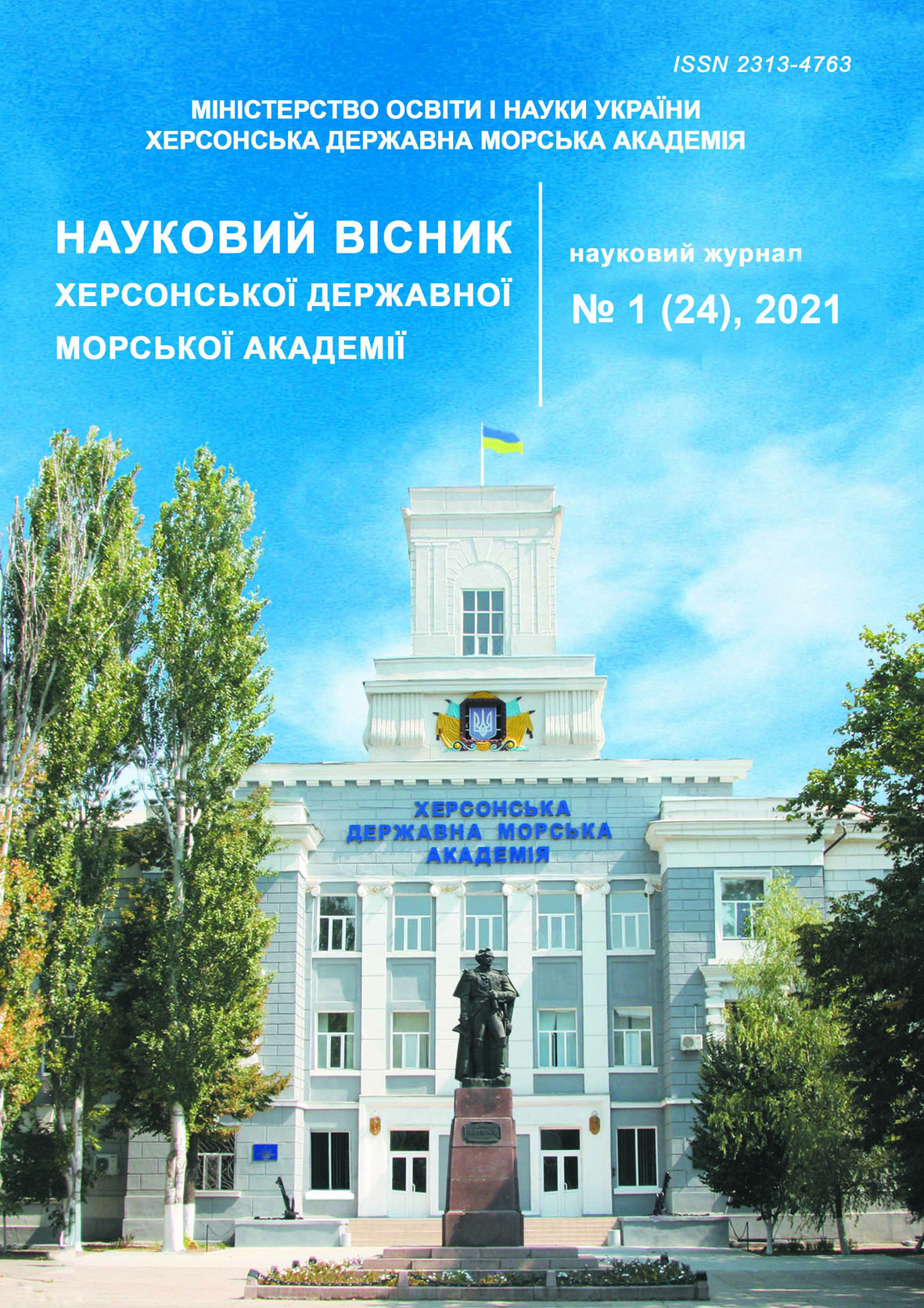THE USE OF INNOVATIVE POLYMER COMPOSITE COATINGS TO IMPROVE THE PERFORMANCE OF TECHNICAL MEANS OF NAVIGATION
10.33815/2313-4763.2021.1.24.072–081
Abstract
It has been testified that among numerous polymer materials, the most practical applications in the field of shipbuilding are reactoplasts based on epoxy binders, due to a range of operational and functional characteristics of the latter. One of the main and most modern means of regulating the structure and
properties of epoxy composite materials is their physical modification by nanofillers of different nature. Based on experimental studies, the effect of physicochemical modifying additive in the form of pigment gas soot, the particle size of which is 24 ± 2 nm, on the thermophysical properties of epoxy diane oligomer brand ED-20 has been studied. As a result of the analysis of the obtained data, it has been discovered that the introduction of pigment gas soot in the amount of q = 1.00 wt.h. leads to a significant reduction in KM shrinkage from δ = 0.032% (for the original matrix) to 0.019%, respectively. It has been proved that with a further increase in the concentration of the additive in the epoxy matrix (q = 25.00 parts by weight), the corresponding values of δ KM do not decrease significantly. This indirectly indicates that the introduction of nanodispersed particles of carbon black at the optimal content provides maximum crosslinking of the composition, and leads to an increase in both mechanical and thermophysical properties of the formed composites. New NCMs and coatings based on them have been developed to restore and improve the performance of technical means of navigation, structures and mechanisms of sea and river transport.
References
2. Emi H., Yuasa M., Kumano A., Yamamoto N., Arima T. & Umino M. A. (1993). Study on life assessment of ships and offshore structures. 3rd report: corrosion control and
condition evaluation for a long life service of the ship. Journal of the Society of Naval Architects of Japan. Vol. 174, 735–747.
3. Soares C. G., Garbatov Y., Zayed A. & Wang G. (2009). Influence of environmental factors on corrosion of ship structures in marine atmosphere. Corrosien Scien 51. DOI 10.1016/j.corsci.2009.05.028
4. Abbas M., Shafiee M. (2020). An overview of maintenance management strategies for corroded steel structures in extreme marine environments. Marine Structures, Vol. 71, 102718, https://doi.org/10.1016/j.marstruc.2020.102718
5. Kolosov O. Ye., Sivetskyi V. I., Sokolskyi O. L., Ivitskyi I. I. & Kurylenko V. M. (2017). Materialy ta tekhnolohii dlia oderzhannia funktsionalnykh polimernykh kompozytsiinykh
materialiv. Naukovi notatky, 58. 184–192.
6. Doncov S. V. (2014). Magnitnihe kompasih : uchebnoe posobie. Odessa : ONMA.
7. Appleyard S. F., Linford R. S., Yarwood P. J. (2005). Marine Electronic Navigation. Abingdon : Routledge.
8. Smirnov E. L., Yalovenko A. V., Perfiljev V. K., Voronov V. V. & Sizov V. V. (2020). Tekhnicheskie sredstva sudovozhdeniya. Konstrukciya i ehkspluataciya: uchebnik dlya vuzov.
Sankt-Peterburg : Ehlmor.
9. Kurnikov A. S., Orekhvo V. A., Efremov S. Yu. (2008). Tekhnologiya sudoremonta : monografiya. Nizhniyj Novgorod : VGAVT.
10. Bazhenov S. L., Berlin A. A., Kuljkov A. A. & Oshmyan V. G. (2010). Polimernihe kompozicionnihe materialih. Dolgoprudnihyj : Izdateljskiyj dom Intellekt.
11. Kurnikov A. S., Orekhvo V. A., Efremov S. Yu. (2008). Tekhnologiya sudoremonta : monografiya. Nizhnij Novgorod : VGAVT.
12. Sapronov O., Buketov A., Sapronova A., Sotsenko V., Brailo M., Yakushchenko S., Maruschak P., Smetankin S., Kulinich A., Kulinich V. & Poberezhna L. (2020). The Influence of the Content and Nature of the Dispersive Filler at the Formation of Coatings for Protection of the Equipment of River and Sea Transport. SAE International Journal of Materials and Manufacturing, Vol. 13(1), 81–91. DOI: https://doi.org/10.4271/05-13-01-0006.
13. Buketov A. V., Brailo M. V., Yakushchenko S. V., Sapronov O. O. & Smetankin S. O. (2020). The formulation of epoxy-polyester matrix with improved physical and mechanical properties for restoration of means of sea and river transport. Journal of Marine Engineering & Technology., Vol. 19. 3, 109–114. DOI: https://doi.org/10.1080/20464177.2018.1530171.
14. Buketov A., Smetankin S., Maruschak P., Yurenin K., Sapronov O., Matvyeyev V. & Menou A. (2020). New black-filled epoxy coatings for repairing surface of equipment of marine ships. Transport, Vol. 35 (6), 679–690. DOI: doi.org/10.3846/transport.2020.14286.
15. Rubino F., Nisticò A., Tucci F. & Carlone P. (2020). Marine Application of Fiber Reinforced Composites, A Review. Journal of Marine Science and Engineering & Technolog.
Vol. 8 (1), 26. DOI:10.3390/jmse8010026.
16. Mouritz A. P., Gellert E., Burchill P. (2001). Review of advanced composite structures for naval ships and submarines. Compos Struct, Vol. 53, 21–41.
17. Buketov A. V., Sapronov A. A., Yacyuk V. N. & Skirdenko V. O. (2014). Issledovanie vliyaniya modifikatora 4,4’-metilenbis (4,1-fenilen)bis (N,N-dietilditiokarbamatu) na strukturu i svoyjstva ehpoksidnoyj matricih. Plasticheskie massih, 7–8, 9–16.
18. Sanzharovskiyj A. T. (1975). Fiziko-mekhanicheskie svoyjstva polimernikh i lakokrasochnikh pokritiyj. Moskva : Khimiya.
19. Buketov A., Smetankin S., Yakushchenko S., Yurenin K., Sotsenko V., Brailo M., Kulinich V., Sapronov O., Kulinich A., Vrublevskyi R. & Bezbakh O. (2021). Physicalmechanical properties of epoxy composites filled with carbon black nano-dispersed powder for protection of transport vehicles. Composites: Mechanics, Computations, Applications: An International Journal, Vol. 12 (2), 1–12. DOI 10.1615/CompMechComputApplIntJ.2021037544.






